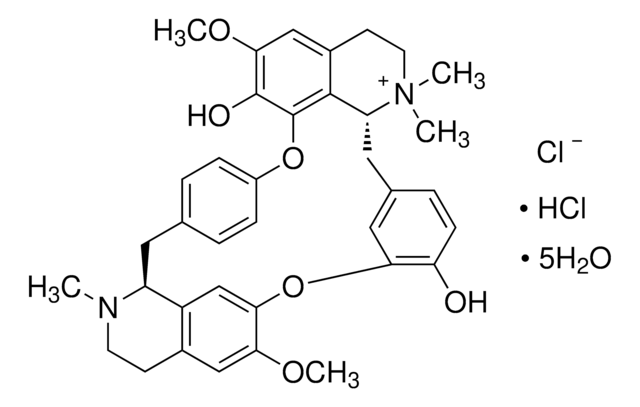93750
(+)-Tubocurarine chloride pentahydrate
≥97.0% (TLC)
Synonyme(s) :
(+)-Tubocurarine chloride hydrochloride pentahydrate, D-Tubocurarine dichloride pentahydrate, Tubarine pentahydrate
About This Item
Produits recommandés
Source biologique
plant
Pureté
≥97.0% (TLC)
Forme
powder
Activité optique
[α]20/D +195±5°, c = 0.5% in H2O
Impuretés
~12% water
Pf
275-280 °C (dec.) (lit.)
Température de stockage
2-8°C
Chaîne SMILES
[Cl-].Cl[H].[H]O[H].[H]O[H].[H]O[H].[H]O[H].[H]O[H].COc1cc2CCN(C)[C@H]3Cc4ccc(Oc5c(O)c(OC)cc6CC[N+](C)(C)[C@H](Cc7ccc(O)c(Oc1cc23)c7)c56)cc4
InChI
1S/C37H40N2O6.2ClH.5H2O/c1-38-14-12-24-19-32(42-4)33-21-27(24)28(38)16-22-6-9-26(10-7-22)44-37-35-25(20-34(43-5)36(37)41)13-15-39(2,3)29(35)17-23-8-11-30(40)31(18-23)45-33;;;;;;;/h6-11,18-21,28-29H,12-17H2,1-5H3,(H-,40,41);2*1H;5*1H2/t28-,29+;;;;;;;/m0......./s1
Clé InChI
WMIZITXEJNQAQK-GGDSLZADSA-N
Informations sur le gène
human ... CHRNA1(1134) , CHRNB1(1140) , CHRND(1144) , CHRNE(1145) , CHRNG(1146)
Vous recherchez des produits similaires ? Visite Guide de comparaison des produits
Application
- as an acetylcholine receptor antagonist in synapse blocking experiment to study its effect on neuromuscular junction formation (NMJ) formation in a co-culture system of human skeletal muscles and human stem cell-derived motoneurons
- to induce paralysis in zebrafish larvae to study whole-brain imaging of seizures by two-photon light-sheet microscopy
- to block NMJ to study its role in myotube contraction
Actions biochimiques/physiologiques
Mention d'avertissement
Danger
Mentions de danger
Conseils de prudence
Classification des risques
Acute Tox. 3 Oral
Code de la classe de stockage
6.1C - Combustible acute toxic Cat.3 / toxic compounds or compounds which causing chronic effects
Classe de danger pour l'eau (WGK)
WGK 3
Point d'éclair (°F)
Not applicable
Point d'éclair (°C)
Not applicable
Équipement de protection individuelle
Eyeshields, Faceshields, Gloves, type P2 (EN 143) respirator cartridges
Certificats d'analyse (COA)
Recherchez un Certificats d'analyse (COA) en saisissant le numéro de lot du produit. Les numéros de lot figurent sur l'étiquette du produit après les mots "Lot" ou "Batch".
Déjà en possession de ce produit ?
Retrouvez la documentation relative aux produits que vous avez récemment achetés dans la Bibliothèque de documents.
Notre équipe de scientifiques dispose d'une expérience dans tous les secteurs de la recherche, notamment en sciences de la vie, science des matériaux, synthèse chimique, chromatographie, analyse et dans de nombreux autres domaines..
Contacter notre Service technique





